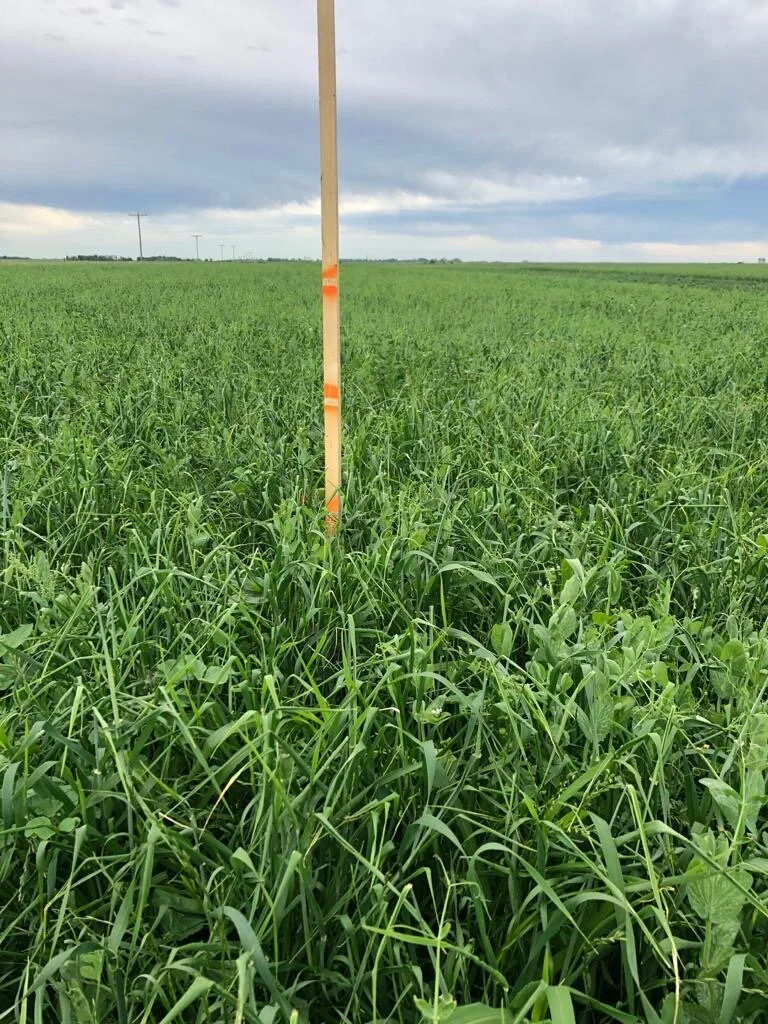Full Season Cover - Silage Protocol
Connecting Farmers To Soil Health
Hello, Friends.
I hope this email finds you well. Today, we will be quickly updating everyone on the silage/dry hay protocol for harvesting the full season cover.
We are really enjoying the picture updates from everyone - keep them coming. It has been really great to see the rapid growth of the full season across Manitoba in the last two weeks!
We have had several questions on ideal "harvest" timing. So here we go...
Plant/Soil Symbiosis
As mentioned last week, the full season has hit what is known as "symbiosis". That is to say, all established plants are working in symbiosis via root exudates, the mycorrhizal fungal network & soil biology.
Notice the difference in the two pictures below from a farm in Souris, Manitoba. The two pictures were taken 11 days apart. The orange markers on the stick represent 1 foot.
Full Season Cover
silage/dry protocol
At this stage in the crops life, cereals will dominate the higher part of the canopy and look as though it is the vast majority of the total biomass. However, the low cereal plant populations allow sunlight to reach lower in the canopy and biomass will be thick right to the surface. The lower sunlight plants will stay vegetative longer, hold more moisture, and thus the cereals can be taken at a higher maturity then if grown in a mono-cropped scenario.
You can get the idea from the tailgate photo. (full season on the right) The cereals consume the upper portion of the canopy but as you descend into the crop, the biomass becomes more legume dominated and vegetative.
When a mono-crop (on the left) hits a certain maturity, the ideal moisture is there but only for a short period of time as the plant naturally dries down.
With the full season cover, the vegetative legumes dominate the surface biomass. The benefits include:
Wider silage window
Increased protein (balanced diet)
Sunlight maximization (no sunlight wasted)
Diverse root exudates = diverse soil biology (workforce)
Balanced C:N Ratio resulting in improved soil aggregation
Full Season Cover
Silage/Dry Hay (continued)
This photo was from last years full-season cover in Clearwater, Manitoba. It was cut on this day in the morning and silaged that same evening at the moisture of 63%.
As you can see, the oats are just starting to naturally turn but the lower canopy legumes are what keeps the moisture ideal. This allows for more growth and biomass.
To keep things simple: we would suggest using the cool season cereal plants as your barometer. Once cool-season cereals start to turn - silage/hay process should begin.
Full season Cover
Dry hay harvest notes
If putting up the blend for dry hay, there are a few things to be considered. The dry down time will be longer, as the vegetative surface biomass will take more time to cure, especially in a windrow. Timing of cutting should still be maximum biomass of the crop. Avoid raking if at all possible, as the added disturbance could cause loss of leaves and seeds from the more mature plants.
full season cover
The re-growth
We will be updating you on regrowth as the time comes. Next week we will have updated images/photos from around the province and have a more detailed harvest timing estimates.
If you have any pictures of your full season, please feel free to send our way so we can include in next weeks email!
Thanks For Reading
To learn more about how we can help incorporate plant diversity into your operation:
Full Season Cover. Click Here
Warm Season Cover. Click Here
Fall Seeded Cover (Silage). Click Here
Fall Seeded Cover (Grain). Click Here
Intercrop Library. Click here
With Gratitude,
Covers & Co. Team
Joseph Gardiner, Travis Avery, Mark Fallis, Owen Taylor




